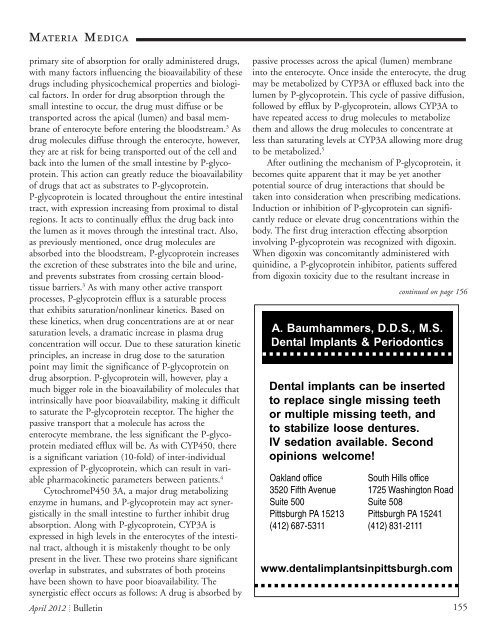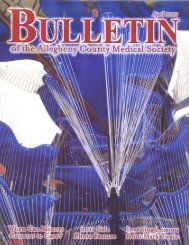Download - Allegheny County Medical Society
Download - Allegheny County Medical Society
Download - Allegheny County Medical Society
You also want an ePaper? Increase the reach of your titles
YUMPU automatically turns print PDFs into web optimized ePapers that Google loves.
MATERIA MEDICA<br />
primary site of absorption for orally administered drugs,<br />
with many factors influencing the bioavailability of these<br />
drugs including physicochemical properties and biological<br />
factors. In order for drug absorption through the<br />
small intestine to occur, the drug must diffuse or be<br />
transported across the apical (lumen) and basal membrane<br />
of enterocyte before entering the bloodstream. 3 As<br />
drug molecules diffuse through the enterocyte, however,<br />
they are at risk for being transported out of the cell and<br />
back into the lumen of the small intestine by P-glycoprotein.<br />
This action can greatly reduce the bioavailability<br />
of drugs that act as substrates to P-glycoprotein.<br />
P-glycoprotein is located throughout the entire intestinal<br />
tract, with expression increasing from proximal to distal<br />
regions. It acts to continually efflux the drug back into<br />
the lumen as it moves through the intestinal tract. Also,<br />
as previously mentioned, once drug molecules are<br />
absorbed into the bloodstream, P-glycoprotein increases<br />
the excretion of these substrates into the bile and urine,<br />
and prevents substrates from crossing certain bloodtissue<br />
barriers. 3 As with many other active transport<br />
processes, P-glycoprotein efflux is a saturable process<br />
that exhibits saturation/nonlinear kinetics. Based on<br />
these kinetics, when drug concentrations are at or near<br />
saturation levels, a dramatic increase in plasma drug<br />
concentration will occur. Due to these saturation kinetic<br />
principles, an increase in drug dose to the saturation<br />
point may limit the significance of P-glycoprotein on<br />
drug absorption. P-glycoprotein will, however, play a<br />
much bigger role in the bioavailability of molecules that<br />
intrinsically have poor bioavailability, making it difficult<br />
to saturate the P-glycoprotein receptor. The higher the<br />
passive transport that a molecule has across the<br />
enterocyte membrane, the less significant the P-glycoprotein<br />
mediated efflux will be. As with CYP450, there<br />
is a significant variation (10-fold) of inter-individual<br />
expression of P-glycoprotein, which can result in variable<br />
pharmacokinetic parameters between patients. 4<br />
CytochromeP450 3A, a major drug metabolizing<br />
enzyme in humans, and P-glycoprotein may act synergistically<br />
in the small intestine to further inhibit drug<br />
absorption. Along with P-glycoprotein, CYP3A is<br />
expressed in high levels in the enterocytes of the intestinal<br />
tract, although it is mistakenly thought to be only<br />
present in the liver. These two proteins share significant<br />
overlap in substrates, and substrates of both proteins<br />
have been shown to have poor bioavailability. The<br />
synergistic effect occurs as follows: A drug is absorbed by<br />
April 2012 : Bulletin<br />
passive processes across the apical (lumen) membrane<br />
into the enterocyte. Once inside the enterocyte, the drug<br />
may be metabolized by CYP3A or effluxed back into the<br />
lumen by P-glycoprotein. This cycle of passive diffusion,<br />
followed by efflux by P-glycoprotein, allows CYP3A to<br />
have repeated access to drug molecules to metabolize<br />
them and allows the drug molecules to concentrate at<br />
less than saturating levels at CYP3A allowing more drug<br />
to be metabolized. 5<br />
After outlining the mechanism of P-glycoprotein, it<br />
becomes quite apparent that it may be yet another<br />
potential source of drug interactions that should be<br />
taken into consideration when prescribing medications.<br />
Induction or inhibition of P-glycoprotein can significantly<br />
reduce or elevate drug concentrations within the<br />
body. The first drug interaction effecting absorption<br />
involving P-glycoprotein was recognized with digoxin.<br />
When digoxin was concomitantly administered with<br />
quinidine, a P-glycoprotein inhibitor, patients suffered<br />
from digoxin toxicity due to the resultant increase in<br />
Oakland office<br />
3520 Fifth Avenue<br />
Suite 500<br />
Pittsburgh PA 15213<br />
(412) 687-5311<br />
continued on page 156<br />
A. Baumhammers, D.D.S., M.S.<br />
Dental Implants & Periodontics<br />
Dental implants can be inserted<br />
to replace single missing teeth<br />
or multiple missing teeth, and<br />
to stabilize loose dentures.<br />
IV sedation available. Second<br />
opinions welcome!<br />
South Hills office<br />
1725 Washington Road<br />
Suite 508<br />
Pittsburgh PA 15241<br />
(412) 831-2111<br />
www.dentalimplantsinpittsburgh.com<br />
155
















